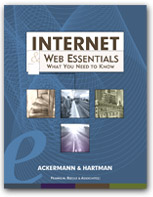Electronic mail allows users on the Internet to communicate with each other
electronically. Using the email program with Netscape Communicator, you can
compose messages and then send them to any other Internet address. You can
read the messages you’ve received, save them to a file, print them, or
delete them. You can also reply to a message or forward one to another Internet
address. There are several other email clients available and other ways to
work with email on the Internet.
An email message consists of three main parts: the headers, which contain
information about the address of the sender, the address of the recipient,
when the message was sent, and other items; the message body, which holds
the text portion of the email; and an optional signature, which holds information
about the sender such as full name, mailing address, phone number, etc. The
signature, which should be limited to four or five lines, is put into a file
that can be automatically included with each message.
In order to send email, you give the Internet address of the recipient,
compose or write the message, and then give a command to send it on its way.
The message is broken up into packets, each containing the address of the
sender and the address of the recipient, and the packets are routed through
several sites on the Internet to the destination. The computer systems on
the Internet handle the transmission and delivery of the email. Once email
arrives at a site, it’s put into a system mailbox for an individual user.
The user can read the email on the system by using an email program like the
one available with Microsoft Outlook Express.
Email is a convenient and efficient means of communication. However,
most communication is done by the text of messages, so you have to be considerate
and careful to communicate effectively, without misunderstandings. Since you
probably have a limited amount of space for your email, be sure to get rid
of unwanted or unnecessary email and also be sure to send concise, appropriate
messages to others. Email isn’t necessarily private. Because it’s
transmitted electronically, there are several opportunities for someone to
read your messages. It’s relatively easy to forward copies of email so
a message sent to one person can be easily transmitted to others.
Email or Internet addresses usually have the form of local-name@domain-name.
Local-name is often the login or user name of the person receiving
the email, and domain-name is the Internet name of the site or computer
system receiving the messages. It’s possible to send email to addresses
on networks not on the Internet. You need to know the proper form of an address
to communicate with users on these networks.
Finding someone’s email address isn’t always easy. There is
no central directory keeping a list of the email address for everyone on the
Internet. If you want to find someone’s address, one of the best things
to do is to call or write that person and ask for the email address. There
are a number of automated services to use to search for an email address.
The email program Outlook Express was discussed in this chapter. It’s
a full-featured email program. You need to set some preferences before using
it. Messages can be saved into folders, and can include text and other types
(images, sounds, programs, spreadsheets, word-processing documents, Web pages,
etc.) of items as part of the message or as attachments. The program includes
an address book. Reading and managing email is done in the mail window, and
you compose email in a message composition window. Online help is available.
Summary | Terms
| Exercises | FYIs

